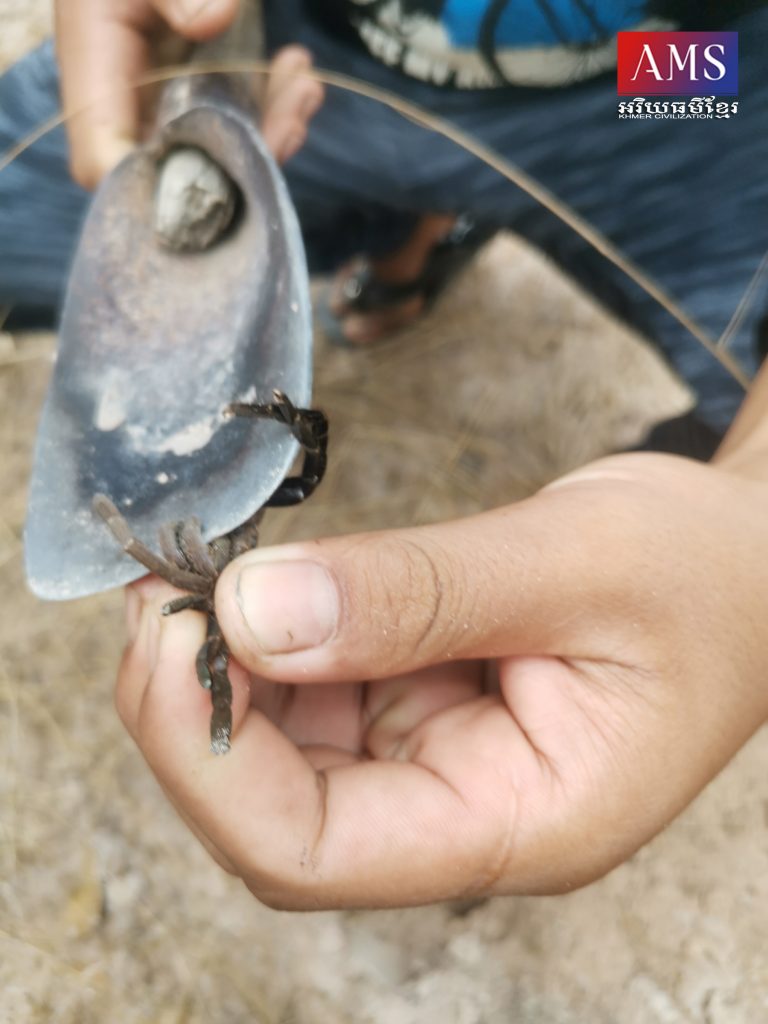ជនជាតិកួយ ជាជនជាតិមួយក្នុងចំណោមជនជាតិដើមភាគតិចទាំង២៤ក្រុមក្នុងប្រទេសកម្ពុជា ដែលមានវត្តមាននៅតំបន់វាលទំនាបខាងជើងបឹងទន្លេសាប ក្នុងទឹកដីនៃខេត្តព្រះវិហារ ខេត្តកំពង់ធំ និងមានតិចតួចនៅខេត្តក្រចេះ។ ជនជាតិនេះរក្សាបាននូវវប្បធម៌ ប្រពៃណី និងទំនៀមទំលាប់រហូតមកដល់បច្ចុប្បន្ន មានដូចជា ភាសា ជំនឿ និងល្បែងល្បាំ សម្រាប់ការប្រតិបត្តិក្នុងសហគមន៍ ជាដើម។ ពួកគេភាគច្រើន រស់នៅដោយការប្រកបរបរចិញ្ចឹមជីវិត ពឹងលើការធ្វើកសិកម្មពនាចរ ការប្រម៉ែប្រមូលអនុផលពីព្រៃឈើ និងមុខរបរផ្សេងៗជាប្រពៃណីរបស់ពួកគេ។
សំណេរផ្លូវការក្នុងវចនានុក្រមខ្មែរសរសេរថា “រពីង”។ ប៉ុន្តែ ភាសាអ្នកស្រុកនៅកំពង់ធំច្រើនហៅសត្វនេះថា “ល្ពីង” និងអ្នកផងទូទៅច្រើនធ្លាប់ស្គាល់ថា “អាពីង”។ ជាធម្មតា តាមមាត់ខ្មែរ ជាពិសេសអ្នកនៅកំពង់ធំ អក្សរ “រ” តែងរត់ទៅជាអក្សរ “ល” មិនមានអ្វីចម្លែកនោះទេ ឧទាហរណ៍ ពាក្យ “រពាក់” គេច្រើននិយាយថា “ល្ពាក់”។ រពីង ជាសត្វមានរូបសណ្ឋានស្រដៀងនឹងពីងពាងធំ មានចង្កូមខុប ធ្វើរន្ធរស់នៅក្នុងដី ព័ទ្ធសរសៃចាក់ស្រេះភ្ជិតមាត់រន្ធ។ រពីង មានពីរយ៉ាង គឺរពីងគោ មានរូបតូច សម្បុរប្រផេះ និងរពីងក្របី មានសម្បុរខ្មៅ រូបធំជាងរពីងគោ។
នៅពេលយើងធ្វើដំណើរចេញពីខេត្តសៀមរាបទៅរាជធានីភ្នំពេញ យើងតែងតែប្រទះឃើញគេលក់សត្វរពីងបំពងនៅទីប្រជុំជនស្គន់ ខេត្តកំពង់ចាម។ អ្នកលក់នៅទីនោះតែងប្រាប់យើងថា ពួកគាត់បានទិញសត្វនេះមកពីខេត្តកំពង់ធំ ភាគច្រើនស្រុកប្រាសាទសំបូរ ស្រុកសណ្តាន់ ស្រុកប្រាសាទបល្ល័ង្ក និងស្រុកស្ទោង។ នៅក្នុងអត្ថបទនេះ យើងនឹងបង្ហាញជូនអំពីប្រពៃណីជីកសត្វល្ពីងរបស់ជនជាតិកួយ ដែលរស់នៅក្នុងភូមិវាលវែង ឃុំឈូក ស្រុកប្រាសាទសំបូរ ខេត្តកំពង់ធំ មកបង្ហាញ។ តើជនជាតិកួយជីកសត្វល្ពីងមានលក្ខណៈពិសេសបែបណាខ្លះ? នៅក្នុងអត្ថបទនេះ យើងនឹងបង្ហាញជូនអំពីប្រពៃណីជីកសត្វល្ពីងរបស់ជនជាតិកួយ ដែលរស់នៅក្នុងភូមិវាលវែង ឃុំឈូក ស្រុកប្រាសាទសំបូរ ខេត្តកំពង់ធំ មកបង្ហាញ។ តើជនជាតិកួយជីកសត្វល្ពីងមានលក្ខណៈពិសេសបែបណាខ្លះ?
ការជីកសត្វល្ពីងមិនសូវមានភាពពិបាកប៉ុន្មានឡើយ ពោល គឺគេគ្រាន់ប្រើប្រាស់ចបជីកមួយ និងដបមួយសម្រាប់ច្រកសត្វល្ពីងគឺគ្រប់គ្រាន់ហើយ។ ជនជាតិកួយតែងសម្គាល់ថា សត្វល្ពីងច្រើនធ្វើរន្ធរស់នៅក្បែរមាត់ទឹក ដូចជា បឹង ត្រពាំង ជាដើម។ គេសម្គាល់ថា រន្ធរបស់សត្វល្ពីង គឺមានសសៃពណ៌សគ្របពីលើរន្ធដូចសំបុកសត្វពីងពាងដែលយើងតែងជួបក្នុងផ្ទះដែរ។
កាលណាបើឃើញរន្ធរបស់សត្វល្ពីងមួយហើយ គេត្រូវសម្គាល់ថា តើរន្ធរបស់វាបែរមុខទៅណា? ប្រសិនបើរន្ធបែរមុខទៅទិសខាងជើង គេត្រូវដើររកមើលទៅទិសខាងជើងប៉ុន្មានម៉ែត្រពីគ្នានឹងច្បាស់ជាឃើញរន្ធរបស់មួយទៀតមិនខាន។ ក្នុងការជីកសត្វល្ពីង គេត្រូវជីកតាមសម្រួល មិនបង្ខំពេកទេ ដោយត្រូវជីកបញ្ឆិតបញ្ឆៀង ព្រោះវាអាចធ្វើឱ្យជីកប៉ះចំល្ពីង ដែលនាំឱ្យសត្វល្ពីងដាច់ខ្លួនជាពីរកំណាត់ ឬងាប់។
ដ្បិតបំណងរបស់អ្នកជីក គឺចង់បានសត្វល្ពីងនៅរស់ និងមានរូបរាងល្អ។ ជាទូទៅ ជីកដល់ជម្រៅដីចាប់ពី ០,១៥ម៉ែត្រ ដល់ ០,២៥ម៉ែត្រ នឹងជួបសត្វល្ពីងហើយ។ ពេលជីកជួបសត្វល្ពីង គេតែងចាប់សត្វល្ពីងកាច់ធ្មេញរបស់វាចោល ដ្បិតធ្មេញរបស់វាមានពិសដែលអាចខាំមនុស្សនាំឱ្យឈឺចុកចាប់បាន។ ប្រការមួយដែលគួរឱ្យចាប់អារម្មណ៍ពីប្រពៃណីរបស់ជនជាតិកួយ គឺពេលគេកាច់ធ្មេញរបស់ល្ពីងគេមានសូត្រឃ្លាមួយថា “កាច់ជើងច អជើងធូ”។ ឃ្លានេះជាភាសាកួយដែលប្រែថា “កាច់ជើងឆ្កែ ល្អជើងល្ពីង”។ ពាក្យ “អ” ត្រូវនឹងភាសាខ្មែរថា “ល្អ” រីឯពាក្យ “ធូ” ត្រូវនឹងភាសាខ្មែរថា “ល្ពីង”។ ជនជាតិកួយជឿថា ការសូត្រនេះគឺជាបាលីមួយដើម្បីកុំឱ្យសត្វល្ពីងខាំ និងក្នុងបំណងសូមឱ្យសត្វល្ពីងនៅរក្សារូបរាងដើមបានល្អ ពោល គឺកាច់តែធ្មេញចោលប៉ុណ្ណោះ។ ការកាច់ធ្មេញសត្វល្ពីង គេត្រូវយកម្រាមដៃចាប់ក្តោបជើងសត្វល្ពីង ហើយយកធ្មេញសត្វល្ពីងមកផ្អឹបជាប់នឹងផ្លែចបជីក រួចយកក្រចកមេដៃកាច់ធ្មេញរបស់ល្ពីង។ បន្ទាប់ពីកាច់ធ្មេញរួចរាល់ គេយកញាត់ល្ពីងចូលក្នុងដបជាការស្រេច។ នៅលើគម្របដបគេត្រូវចោះរន្ធបន្តិច ដើម្បីមានខ្យល់ចេញចូលខ្លះ បង្ការកុំឱ្យល្ពីងងាប់។ អ្នកជីកល្ពីងជាជនជាតិកួយប្រាប់ថា ជាទូទៅល្ពីងសម្បូណ៌និងមានរូបរាងធំធាត់ខ្លាំងនៅរវាងខែពិសាខ ពោល គឺដើមរដូវធ្លាក់ភ្លៀង។ ពួកគាត់តែងលក់សត្វល្ពីងដែលជីកបានទៅឱ្យឈ្មួញកណ្តាលក្នុងមួយក្បាលតម្លៃចាប់ពី ៣០០ ដល់ ១០០០ រៀល តាមតូចតាមធំ។ ពេលខ្លះគាត់មិនលក់ទេ គឺយកអាំងពិសារ និងដាក់ត្រាំស្រាក៏បាន។
The Kuy are one of 24 indigenous groups in Cambodia that are present in the lowlands north of the Tonle Sap Lake in the territory of Preah Vihear, Kampong Thom, and a few in Kratie. They have maintained their culture, traditions and customs to this day, such as language, beliefs and folk games for community practice. Most of them live on subsistence farming, harvesting non-timber forest products and other traditional occupations. In this article, we will present the spider digging tradition of the Kuay people living in Veal Veng village, Chhouk commune, Prasat Sambo district, Kampong Thom province. What are the special features of Kuay digging spiders?
Spiders are a language that local in Kampong Thom refer to a species that commonly know as “spiders” and are poisonous species that make holes in the ground. When we travel from Siem Reap to Phnom Penh, we often see people selling fried spiders in Skun town, Kampong Cham province. Vendors often tell us that they bought this animal from Kampong Thom province, mostly in Prasat Sambo, Sandan, Prasat Balang and Stong districts.
Digging spiders is not so difficult, just use a spade and a bottle for spiders are enough. The Kuy people often notice that many spiders make holes to live near the waterfront, such as lakes and ponds, etc. It is noted that the spider’s hole is covered with white fibers, just like the spider’s nest which we always see in the house. When they see a spider’s hole, they have to mark where its hole is facing. If the hole faces north, they have to look north a few meters apart then will definitely see another hole. In digging spiders, it is necessary to dig in a way that is not too forced because it can be the digging to touch the spiders, leading to the spiders splitting into two pieces or drying. The purpose of the digger is to get the spider alive and in good shape. Generally, digging to a depth of 0.15 m to 0.25 m will find spiders. When they see spiders during digging, they often catch spiders and cut off their teeth because their teeth are so poisonous that they can bite people and cause pain. One of the interesting things about the Kuy tradition is that when they break the spider’s teeth, they have a phrase that says, “Kach Cheung Chau, Or Cheung Thou.” This phrase is in the Kuy language, which translates as “break dog leg, good spider leg.” The word “Or” corresponds to the Khmer word “Lior (good)” and the word “Thou” corresponds to the Khmer word “Liping (spider)”. After the teeth are cut, the spider is put into a bottle. On the bottle cap, a small hole is drilled to allow some ventilation to prevent the spider from dying. Kuy spider diggers say that spiders are generally abundant and very large during the month of April or May, the beginning of the rainy season. They often sell the spiders to brokers for between 300 and 1,000 riels, depending on the size. Sometimes they do not sell but roast it for making traditional wine.
អត្ថបទដើម៖ លោក ម៉ង់ វាលី










